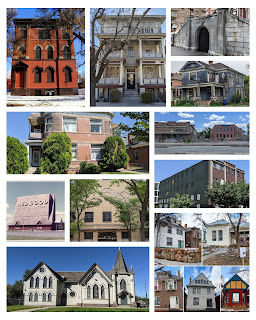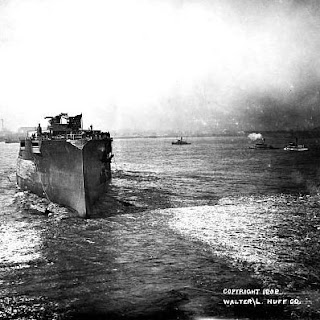Another local Salt Lake City controversy regarding the USS Utah was the traditional gift of a silver service.
 |
USS Utah silver service.
Image from Naval History and Heritage Command |
After the
USS Utah was launched in 1909 (
previous post), the ship underwent 2 years of sea trials before receiving its commission on August 31, 1911. During this 2 year period, Utah Governor William Spry began his campaign to fund the traditional gifting of a silver service for use by officers of the ship.
Probably taking a cue from the earlier commissioning of the
USS Utah’s sister ship, the
USS Florida, Spry initiated a campaign to seek donations from Utah’s school children to pay for the silver service rather than having the Utah Legislature appropriate the money. His rationale was that Utah was home to families with many children and if each one of the 104,000 school children in Utah donated 10 cents (~$3 today) it would raise a budget of $10,000 (~$293K today).
The $10,000 budget was equivalent to the USS Florida, and rather modest compared to other state's silver service budgets. When the fundraising was over, a total of 26,477 children were listed as contributing $2,277.42, far short of the $10,000 goal and in the end, the Utah Legislature appropriated the remaining funds.
Traditionally, the design and size of the silver service were decided by the namesake state, and the design incorporated the symbols, history, flora, and fauna of the state.
The controversy was the design of a single tray from the silver service which depicted the street view of the Brigham Young Monument with the LDS Temple.
 |
Detail of the coffee tray with Brigham Young Monument
Image from Naval History and Heritage Command
|
Again, just like with the launching ceremony of the USS Utah, this decision was seen by the non-Mormon population of SLC that the state and federal governments were officially endorsing the Mormon religion and idolizing the leader who encouraged polygamy- a practice that was controversial and believed to still be practiced in secret.
Once all the designs were made public it was Mrs. Erna Owen (nee von Rodenstein) who furiously objected. Erna was a relative newcomer having only lived in SLC for 2 years. She and her husband were from Connecticut where Erna was a society woman and her husband, Herbert, was a top mogul in the bicycle world. He was the first to ride down the steps of the US Capitol on a bicycle and was the inventor of the safety bicycle and the woman’s drop-frame bicycle, which he said would enable women’s independence.
Erna was seen by most residents of Salt Lake City as an outsider just making trouble and no one paid her much attention; even the Salt Lake Tribune mostly ignored her protests until she began mobilizing prominent non-Mormons in SLC (members of the American political party) and talking with her contacts on the east coast, which started a mild national interest in the controversy.
In the end, the Navy decided to accept the full silver service in 1911, including the tray with Brigham Young. Previous precedent of accepting controversial images was set in 1909 when the Navy accepted a silver plate with Confederate President Jefferson Davis on it for the USS Mississippi.
The Navy also accepted a silver tray from Erna that had a woman with the American flag. She hoped it would replace the Brigham Young tray, but it eventually ended up framed on the bulkhead of the captain's cabin.
When the USS Utah became a target ship in 1930, Utah Governor George Dern requested the silver service be returned. The Navy refused so Utah Senator William King introduced a bill in Congress to mandate its return to Utah; the bill was passed and signed by President Herbert Hoover.
The silver service is now in procession of the Utah Division of State History; however, some items have been lost or stolen and the service is no longer complete.
Source: Silver Service for the Battleship Utah; A Naval Tradition under Governor Spry by Michael S Eldredge. Utah Historical Quarterly. 1978. Vol. 46, No. 3.
OF NOTE: After Erna Owens left Utah and went back to Connecticut, she became a well-known activist for women’s rights. She was part of the votes for women movement, and she spearheaded the Women’s Radio Corps during WWI which supplied the military with women radio operators. Her daughter, Elsie, was also part of the Women’s Radio Corps and became a pilot for the military during WWII
 |
| Large waiter tray displaying pioneers and covered wagons contrasted with the modern transportation of a train on the Lucin Cutoff |
 |
| Large Centerpiece (top) displaying the workings of the Utah Copper Company at Bigham and the Copperton Mills; sego lilies frame mining scene and the handles are eagle heads |
 |
| Cloche with H.L.A. Culmer’s “Caroline Bridge” now also known as Kachina Bridge |
 |
| Cloche with the Devil’s Slide rock formation |
 |
| Waiter tray displaying Cyrus E Dallin’s “Signal of Peace” |
 |
| Platter displaying a train and mountain scene |
 |
| Large Punch Bowl displaying Black Rock and the Great Salt Lake on one side and Battleship Utah on the other, the handles of the bowl are seagull heads |
 |
| Cigar box made of solid Utah Copper displaying Salt Lake High School’s 300 naval cadets on the silver plate attached on top |
 |
Utah Governor William Spry at the silver service presentation ceremony onboard the USS Utah, 1911.
Image from Utah Division of History |
-------------------------
Here is an incomplete list of the engraved pieces of the
USS Utah's Silver Service that I was able to find through historic photographs and newspaper descriptions. Of note, all the silver was mined in Utah.
- Coffee tray displaying the Brigham Young Monument in front of LDS Temple
- Unknown item displaying Lake Blanche and the Wasatch Mountains
- Unknown item displaying Mahonri Mackintosh Young’s “the Prospector”
- Large waiter tray displaying pioneers and covered wagons contrasted with the modern transportation of a train on the Lucin Cutoff
- Waiter tray displaying Cyrus E Dallin’s “Signal of Peace”
- Cigar box made of solid Utah Copper displaying Salt Lake High School’s 300 naval cadets on the silver plate attached on top
- Large Punch Bowl displaying Black Rock and the Great Salt Lake on one side and Battleship Utah on the other, the handles of the bowl are seagull heads
- Large Centerpiece displaying the workings of the Utah Copper Company at Bigham and the Copperton Mills; sego lilies frame mining scene and the handles are eagle heads
- Well and Tree Steak platter with scallops and fish motif.
- Fish platter with “Utah” engraved
- Platter displaying a train and mountain scene
- Cloche with the Devil’s Slide rock formation
- Cloche with H.L.A. Culmer’s “Caroline Bridge” now also known as Kachina Bridge
- Unknown item with H.L.A. Culmer’s “Augusta Bridge” now also known as Sipapu Bridge
- Bowl displaying the Wasatch Mountains, taken from a Shipler photograph
- Square tray displaying Eagles Gate
- Candelabras displaying a (written?) tribute to the Utah men who died in the Spanish-American War
- Other items adorned with sea creatures, the Seal of Utah, and the Seal of the US Navy
The large punch bowl was accompanied by 27 punch cups representing Utah’s 27 counties. The designs for the counties I could find descriptions are listed here:
- Salt Lake County displaying the Salt Lake City and County Building
- Millard County displaying the Utah Territorial Statehouse
- Juab County displaying a mining scene
- Summit County displaying a mining scene
- Washington County displaying grapes, fig, and pomegranate
- Cache County displaying a bundle of wheat
- Box Elder County displaying the Bear River irrigation system
- Wasatch County displaying the old probate seal bearing in the center a deer head
- Morgan County displaying a potato
- Garfield County displaying a merino ram
- Uinta County displaying a brontosaurus
- Kane County displaying steers
- Wayne County displaying an oil scene
- San Juan County displaying a natural bridge

































